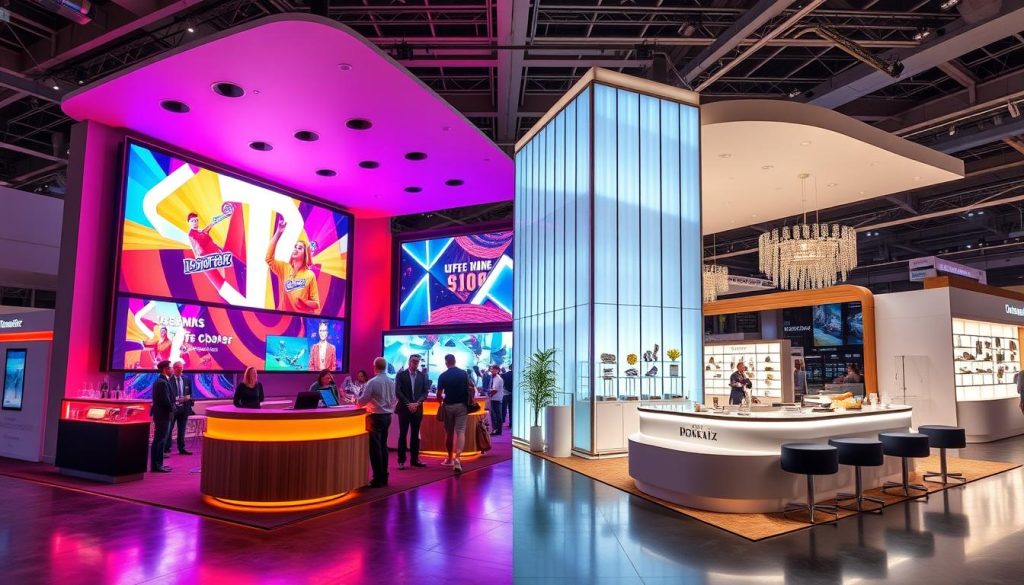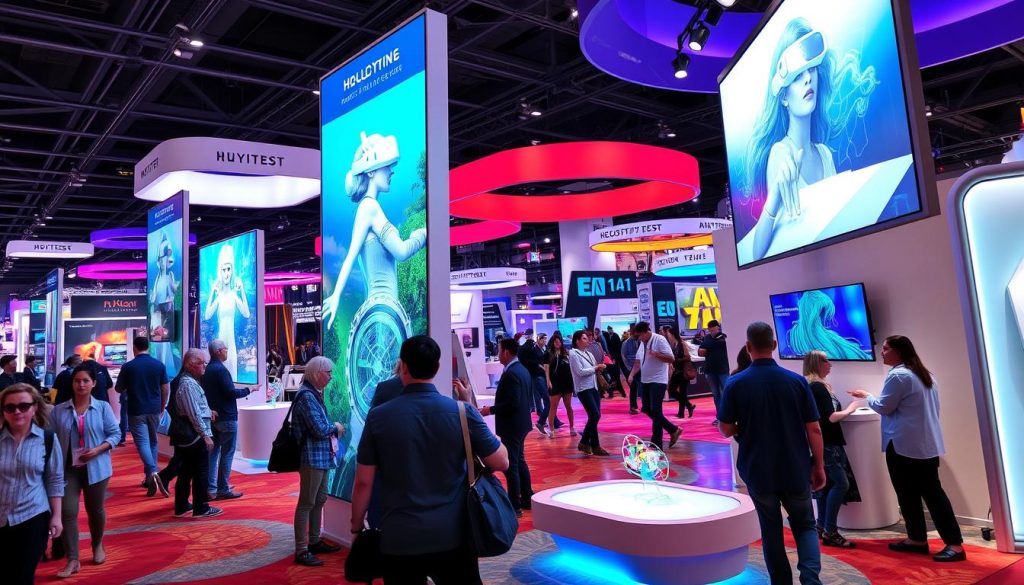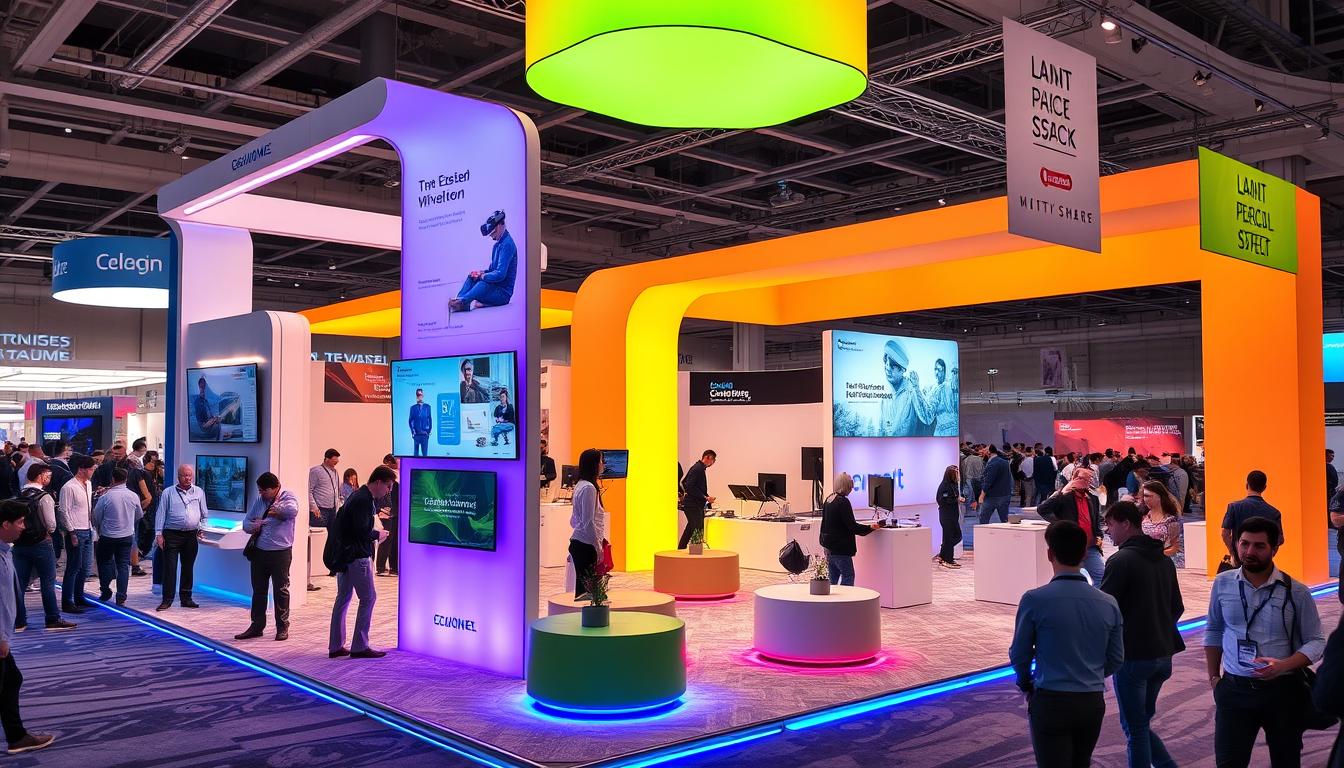Trade shows have long been a cornerstone of event engagement and experiential marketing. As the landscape evolves, businesses face a crucial decision: stick with traditional booth setups or embrace interactive games and technologies. This choice can make or break your trade show marketing strategy, affecting everything from attendee interactions to overall return on investment.
The rise of digital tools has transformed how companies approach these events. Interactive booths now offer immersive experiences that captivate audiences in ways static displays simply can’t match. Yet, traditional setups still hold value for certain brands and industries. Understanding the strengths of each approach is key to crafting a winning exhibition strategy.
As we delve into the world of modern trade show marketing, we’ll explore how interactive elements are reshaping attendee expectations and examine the enduring appeal of classic booth designs. This comparison will help you navigate the exciting possibilities for your next event, ensuring your brand stands out in today’s competitive marketplace.
Key Takeaways
- Interactive booths enhance event engagement through immersive experiences
- Traditional setups remain effective for certain brands and industries
- Digital tools are transforming trade show marketing strategies
- Choosing between interactive and traditional approaches impacts ROI
- Understanding both methods is crucial for effective experiential marketing
- Modern trade shows blend digital and physical elements for optimal impact
Understanding Modern Trade Show Booth Evolution
Trade show booths have come a long way from simple displays to dynamic, engaging experiences. The evolution of booth design strategies reflects changing consumer expectations and technological advancements.
The Historical Development of Trade Show Displays
In the past, trade show booths were static affairs with brochures and product samples. Today, they’ve transformed into interactive exhibits that captivate attendees. This shift mirrors the evolution of marketing strategies, where engagement is key.
Current Trends in Exhibition Marketing
Modern trade shows prioritize immersive experiences. Brands now focus on creating memorable interactions rather than simply showcasing products. Gamification has emerged as a powerful tool, turning passive observers into active participants.
The Digital Transformation of Booth Experiences
Technology has revolutionized booth design. Interactive touchscreens, virtual reality demonstrations, and augmented reality applications are now commonplace. These digital elements enhance engagement and provide valuable data on visitor interactions, much like targeted email marketing campaigns.
| Traditional Booths | Modern Interactive Booths |
|---|---|
| Static displays | Dynamic touchscreens |
| Print brochures | Digital content delivery |
| Limited data collection | Real-time analytics |
As trade shows continue to evolve, successful exhibitors will need to balance innovative technology with meaningful human interactions to create lasting impressions.
Interactive Games vs. Traditional Booth Setups: What Works Best?
Trade show success hinges on creating an unforgettable attendee experience. The debate between interactive games and traditional booth setups is heating up as brands seek effective lead generation tactics. Let’s explore what works best in today’s competitive exhibition landscape.
Interactive games captivate visitors, offering a fun and engaging way to learn about products or services. They create memorable moments, increasing brand recall. On the flip side, traditional booths provide a familiar setting for in-depth conversations and product demonstrations.
To determine what works best, consider these factors:
- Target audience preferences
- Product complexity
- Brand personality
- Available budget
- Space constraints
Let’s compare the two approaches:
| Aspect | Interactive Games | Traditional Booths |
|---|---|---|
| Attendee Engagement | High, immersive experience | Moderate, focused interactions |
| Lead Generation | Digital data collection | Manual information gathering |
| Brand Recall | Strong, due to unique experiences | Varies, depends on presentation |
| Setup Complexity | Higher, requires tech support | Lower, familiar logistics |
| Cost | Higher initial investment | Lower upfront costs |
Ultimately, the best approach combines elements of both. A hybrid setup can leverage the strengths of interactive games and traditional booth designs, creating a well-rounded attendee experience that drives engagement and boosts lead generation tactics.
Key Components of Interactive Trade Show Booths
Interactive trade show booths have revolutionized the way companies engage with potential clients. These booths blend cutting-edge technology with creative design to create memorable experiences. Let’s explore the key elements that make these exhibits stand out.
Digital Engagement Tools and Technologies
Modern trade show booths leverage digital tools to captivate visitors. Touchscreens, virtual reality headsets, and augmented reality apps transform passive viewers into active participants. These technologies allow companies to showcase products in innovative ways, creating engaging landing pages for post-event follow-ups.
Interactive Display Solutions
Interactive exhibits go beyond static displays. They feature dynamic content that responds to visitor input. Motion-activated screens, interactive product demos, and 3D holographic displays create immersive experiences. These solutions help brands tell their story in a way that resonates with attendees.
Gamification Elements in Modern Booths
Gamification has become a powerful tool in experiential marketing. Trade show booths now incorporate games, quizzes, and challenges that educate visitors about products while entertaining them. These elements boost engagement, increase dwell time, and create a fun, competitive atmosphere that attendees remember long after the event.
“Interactive booths turn passive observers into engaged participants, leaving lasting impressions that traditional setups can’t match.”
By combining these components, companies create trade show experiences that are not just informative but truly unforgettable. The fusion of technology, interactivity, and gamification transforms ordinary booths into powerful marketing tools that drive brand awareness and lead generation.
Traditional Booth Design Elements and Their Impact
Trade show booth design strategies have evolved, yet traditional elements continue to play a crucial role in brand activation and attendee experience. Classic design principles create a foundation for effective engagement, even in today’s tech-driven landscape.
Signage remains a cornerstone of booth design. Clear, eye-catching banners and logos help attendees quickly identify brands. Lighting, when used strategically, can highlight key products or create an inviting atmosphere. These elements work together to draw visitors in and make a lasting impression.
Product displays are another vital component. Well-organized exhibits allow attendees to interact with offerings hands-on, enhancing their experience. This tactile engagement can be particularly effective for industries where physical products are key to sales.
Comfortable seating areas encourage longer conversations, fostering deeper connections between brand representatives and potential clients. These spaces can serve as impromptu meeting rooms, facilitating more meaningful interactions on the busy show floor.
“The most effective booth designs blend traditional elements with modern touches, creating a seamless attendee experience that resonates long after the event ends.”
While digital integration is important, traditional design elements provide a tangible, memorable experience that can’t be replicated online. By skillfully combining these timeless strategies with innovative approaches, brands can create powerful, lasting impressions at trade shows.
Measuring ROI: Interactive vs Traditional Approaches
Trade show marketing strategies have evolved, making it crucial to measure return on investment (ROI) accurately. Let’s explore how interactive and traditional booths stack up in terms of lead generation tactics and event engagement.
Lead Generation Metrics Comparison
Interactive booths often outperform traditional setups in lead generation. Digital tools allow for faster data collection and follow-up. A study by Omni Online Strategies found that interactive booths captured 40% more leads than their traditional counterparts.
| Metric | Interactive Booth | Traditional Booth |
|---|---|---|
| Lead Capture Rate | 75% | 50% |
| Lead Quality Score | 8.5/10 | 6.5/10 |
| Follow-up Response Rate | 65% | 40% |
Attendee Engagement Analytics
Event engagement metrics reveal the effectiveness of different booth types. Interactive booths typically see higher dwell times and participation rates. Digital interactions provide valuable data on attendee preferences and behaviors.
Cost-Benefit Analysis Methods
While interactive booths may have higher upfront costs, they often yield better long-term results. Consider factors like booth setup expenses, staff training, and potential revenue from leads generated. A comprehensive cost-benefit analysis helps determine the most effective trade show marketing approach for your business.
“Interactive booths deliver a 30% higher ROI compared to traditional setups over a three-year period.” – Trade Show Experts Association
By leveraging these metrics and analysis methods, businesses can make informed decisions about their exhibition strategies, maximizing their trade show ROI.
Strategies for Successful Brand Activation in Both Formats
Brand activation at trade shows requires a mix of creativity and strategy. Whether you’re using interactive or traditional booths, the goal is to leave a lasting impression on attendees. Let’s explore some effective approaches for both formats.
Creating Memorable Brand Experiences
Experiential marketing is key to successful brand activation. Engage visitors’ senses with unique displays, interactive demos, or product samples. For example, a food brand might offer taste tests, while a tech company could provide hands-on product trials. These experiences create emotional connections and boost brand recall.

Integrating Digital and Physical Elements
Blend digital and physical elements in your booth design strategies. Use touchscreens for product information, virtual reality for immersive experiences, or augmented reality for interactive product demonstrations. This fusion caters to tech-savvy attendees while maintaining the human touch of face-to-face interactions.
Staff Training for Different Booth Types
Your team is crucial to brand activation success. Train staff on product knowledge, engagement techniques, and tech use. For interactive booths, focus on guiding visitors through digital experiences. In traditional setups, emphasize personal connections and storytelling. Either way, ensure your team embodies your brand values and messaging.
“The best brand activations seamlessly blend technology with human interaction, creating unforgettable experiences for trade show attendees.”
By implementing these strategies, you’ll create a powerful brand presence that resonates with your audience long after the event ends.
The Psychology of Attendee Engagement
Understanding the psychology behind attendee engagement is crucial for creating successful trade show experiences. Event organizers and exhibitors can leverage psychological principles to enhance attendee experience and boost event engagement.
One key aspect of attendee psychology is the desire for interactive experiences. Gamification elements tap into this need, providing a fun and memorable way to engage with brands. For example, interactive games at booths can increase visitor dwell time and improve information retention.
The psychology of color plays a significant role in booth design. Certain colors evoke specific emotions and can influence attendee behavior:
- Red: Excitement and urgency
- Blue: Trust and stability
- Green: Growth and harmony
- Yellow: Optimism and creativity
Cognitive load theory suggests that attendees can process only a limited amount of information at once. To optimize engagement, booth designs should balance stimulation with simplicity. This approach helps prevent information overload and enhances the overall attendee experience.
“The key to successful attendee engagement lies in understanding human behavior and creating experiences that resonate on a psychological level.”
| Psychological Factor | Impact on Attendee Experience | Implementation Strategy |
|---|---|---|
| Social Proof | Increases trust and participation | Display testimonials or live social media feeds |
| Scarcity | Creates urgency and value perception | Offer limited-time booth promotions |
| Reciprocity | Encourages engagement and follow-ups | Provide valuable giveaways or information |
By applying these psychological insights, exhibitors can create more engaging and effective booth experiences that leave a lasting impression on attendees.
Technology Integration and Implementation Challenges
Integrating cutting-edge technology into trade show booths can be a game-changer for exhibitors. Yet, it comes with its own set of hurdles. Let’s explore the common issues and smart solutions for tech-savvy booth design strategies.
Common Technical Issues and Solutions
Trade show marketing often faces connectivity problems. Weak Wi-Fi signals can disrupt interactive exhibits. A solution? Bring your own hotspot or arrange dedicated internet lines. Power outages are another concern. Always have backup batteries and portable chargers on hand.

Budget Considerations for Tech Integration
Implementing high-tech booth design strategies can be costly. Balance innovation with budget by prioritizing key interactive elements. Consider renting equipment instead of buying to cut costs. Effective marketing strategies, like targeted email campaigns, can help justify the expense by boosting attendance and engagement.
Future-Proofing Your Booth Design
To stay ahead in trade show marketing, design flexible booth layouts that can adapt to new technologies. Invest in modular components that allow for easy updates. Keep an eye on emerging trends like augmented reality and artificial intelligence to incorporate them into your future exhibits.
“The future belongs to those who prepare for it today.” – Malcolm X
By addressing these challenges head-on, exhibitors can create memorable interactive exhibits that stand out on the trade show floor. With careful planning and smart investments, your booth can become a beacon of innovation in the ever-evolving world of trade show marketing.
Best Practices for Hybrid Booth Experiences
Creating a hybrid booth that blends interactive exhibits with traditional setups is key to modern experiential marketing. These booths offer the best of both worlds, engaging attendees through innovative technology while maintaining familiar elements.
To craft an effective hybrid experience, balance digital and physical components. Use touchscreens and virtual reality alongside physical product displays. This mix caters to diverse preferences and enhances brand activation efforts.
Space optimization is crucial in hybrid booths. Design a layout that guides visitors through both interactive and traditional areas seamlessly. Consider using modular elements that can be rearranged to suit different events or themes.
Staff training is vital for hybrid success. Ensure your team can navigate both high-tech features and conventional sales techniques. This versatility allows them to adapt to each visitor’s comfort level with technology.
“Hybrid booths are the future of trade show marketing, offering unparalleled engagement opportunities.”
Incorporate data collection tools throughout your booth. Use digital sign-ins, QR codes, and interactive surveys to gather valuable insights. This data helps refine your approach and measure ROI effectively.
Remember, the goal is to create a cohesive brand experience. Ensure all elements, both digital and physical, align with your brand identity and messaging. This consistency reinforces your brand image and makes a lasting impression on attendees.
Conclusion
The world of trade show marketing has evolved, leaving businesses to wonder what works best for event engagement. Interactive games and traditional booth setups each offer unique advantages. The key is finding the right mix that aligns with your brand and goals.
Interactive elements can boost attendee engagement, creating memorable experiences that stick long after the event ends. They offer exciting ways to showcase products and services, making your booth a must-visit destination. Traditional setups, on the other hand, provide a familiar format that some attendees prefer, especially for in-depth conversations.
Ultimately, successful trade show marketing hinges on understanding your audience and adapting your approach. Whether you choose interactive games, traditional displays, or a blend of both, focus on creating genuine connections. By staying flexible and open to new ideas, you’ll be well-equipped to make a lasting impression in the ever-changing landscape of trade show marketing.
FAQ
What are the main differences between interactive and traditional trade show booths?
Interactive booths typically feature digital engagement tools, gamification elements, and interactive displays, while traditional booths focus on static displays, printed materials, and face-to-face interactions. Interactive booths aim to create immersive experiences, while traditional booths rely on classic marketing techniques.
How do interactive games enhance attendee engagement at trade shows?
Interactive games enhance engagement by creating memorable experiences, encouraging active participation, and leveraging gamification techniques. They can increase dwell time at booths, facilitate data collection, and create opportunities for personalized interactions with potential leads.
Are traditional booth setups still effective in modern trade shows?
Yes, traditional booth setups can still be effective when executed well. They offer familiarity, allow for direct conversations, and can be cost-effective. Many successful exhibitors combine traditional elements with modern interactive features to create a balanced approach.
How can I measure the ROI of my trade show booth?
Measure ROI by tracking lead generation metrics, analyzing attendee engagement data, and conducting a cost-benefit analysis. Compare the number and quality of leads generated, booth traffic, and post-event sales conversions against your investment in the booth and overall event participation.
What are some effective brand activation strategies for trade shows?
Effective brand activation strategies include creating memorable experiences, integrating digital and physical elements, providing hands-on product demonstrations, offering personalized interactions, and training staff to engage attendees effectively. Consider using a mix of interactive and traditional elements to appeal to a wide range of visitors.
How can I incorporate technology into my booth design without breaking the bank?
Start by focusing on cost-effective technologies like touchscreen displays, mobile apps, or simple interactive games. Consider renting equipment instead of purchasing, and prioritize technologies that align closely with your marketing goals. Gradually introduce more advanced features as your budget allows.
What are some common challenges in implementing interactive exhibits?
Common challenges include technical issues (e.g., connectivity problems, software glitches), high initial costs, staff training requirements, and ensuring the technology aligns with your brand message. It’s important to have technical support on hand and a backup plan in case of malfunctions.
How do I create a hybrid booth experience that combines interactive and traditional elements?
To create a hybrid booth, balance digital and physical components by integrating interactive displays with traditional product showcases. Use technology to enhance, not replace, face-to-face interactions. Ensure a cohesive design that guides visitors through both interactive and traditional areas seamlessly.
What psychological factors influence attendee engagement at trade shows?
Key psychological factors include novelty (attracting attention with unique experiences), social proof (showcasing popularity or testimonials), reciprocity (offering value to attendees), and cognitive ease (making information easily digestible). Understanding these can help design more engaging booth experiences.
How can I future-proof my booth design?
To future-proof your booth, invest in flexible, modular designs that can be easily updated or reconfigured. Choose technology platforms that can be upgraded or expanded over time. Stay informed about industry trends and be prepared to adapt your strategy based on changing attendee preferences and technological advancements.


